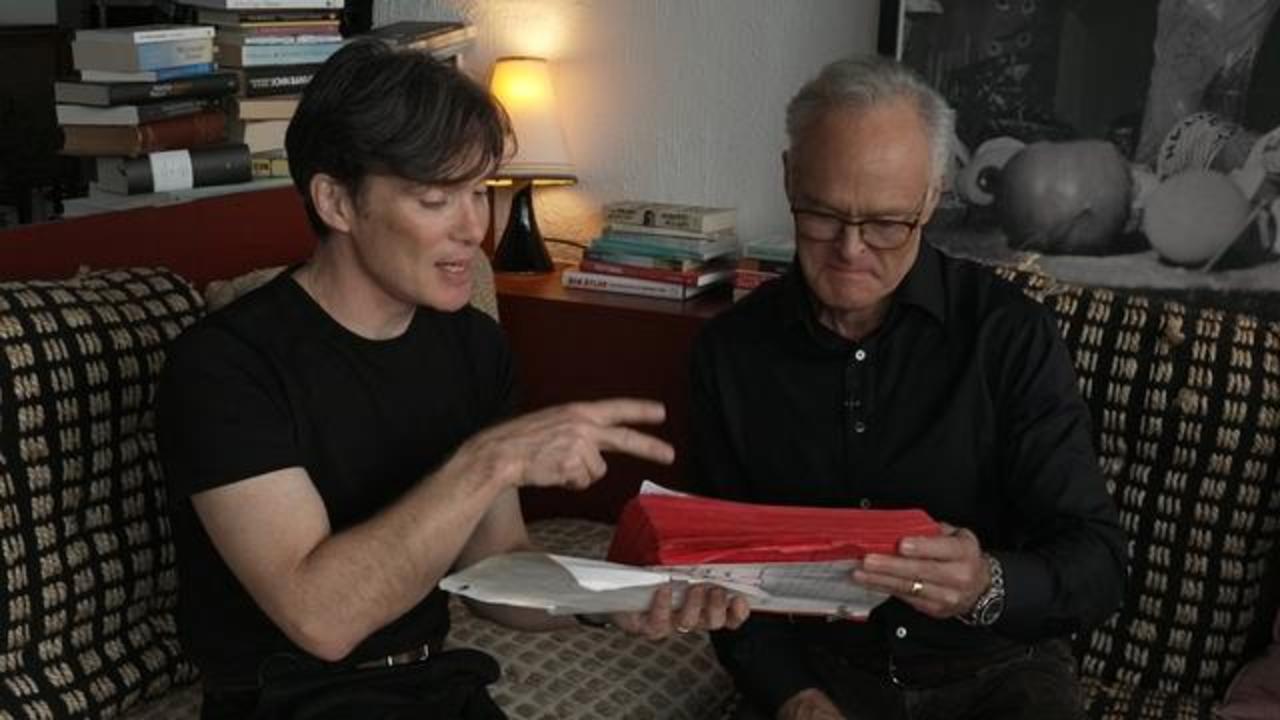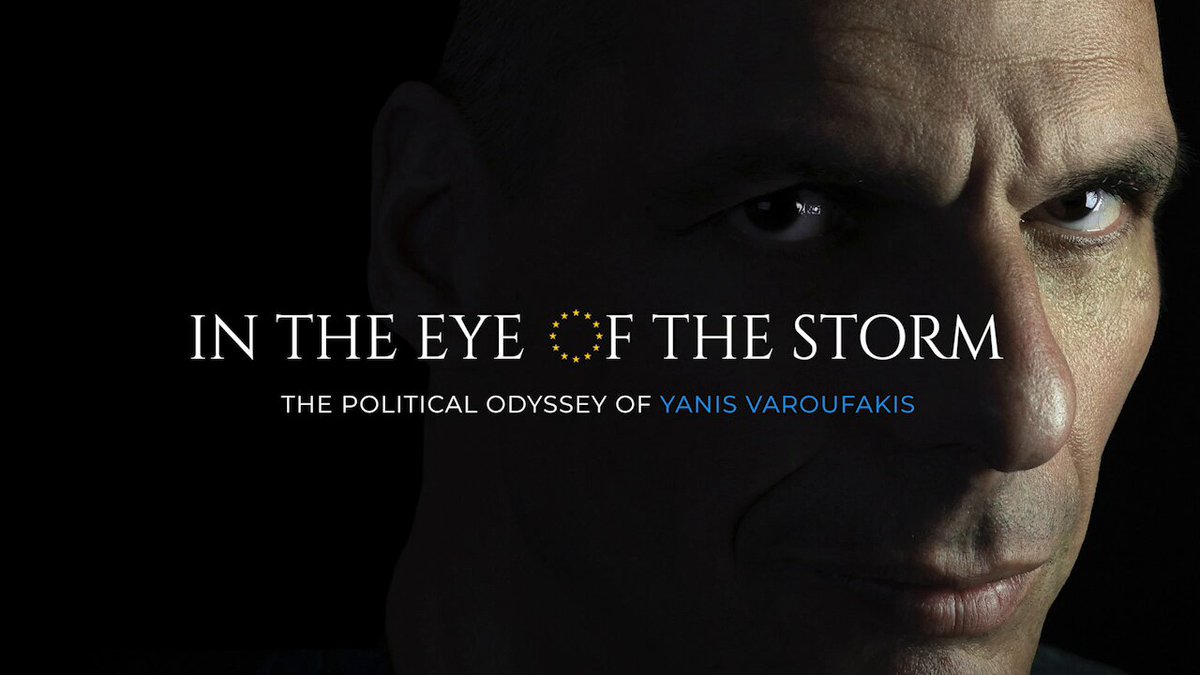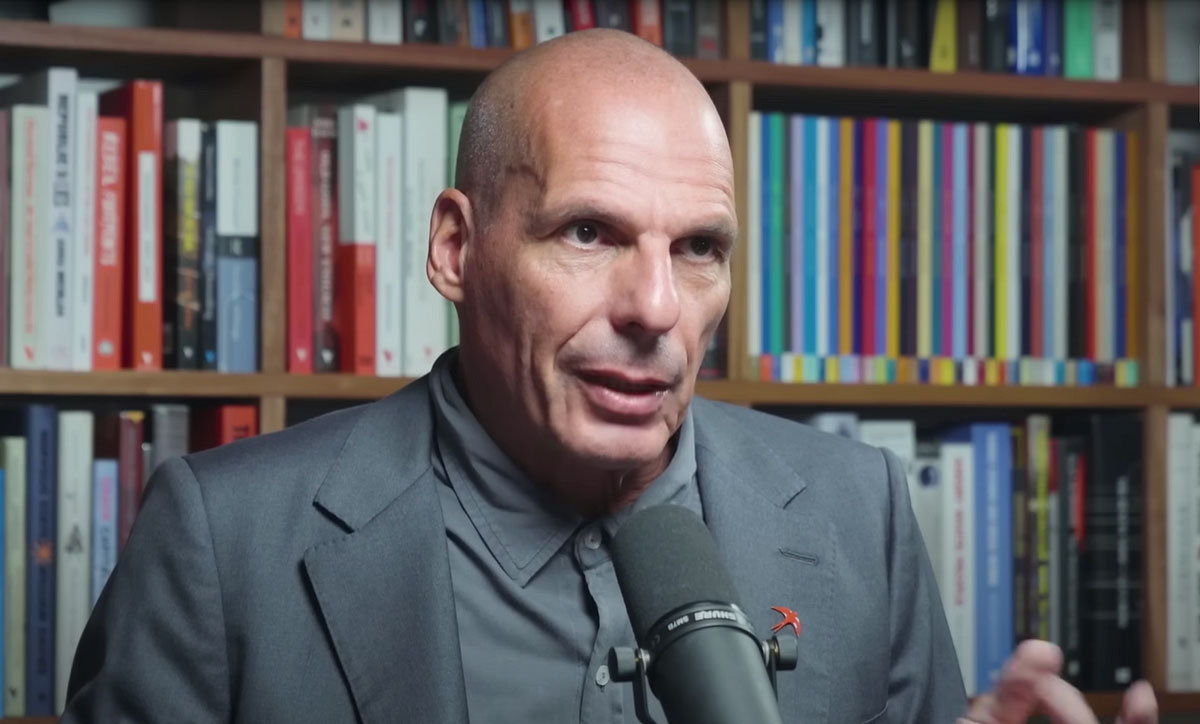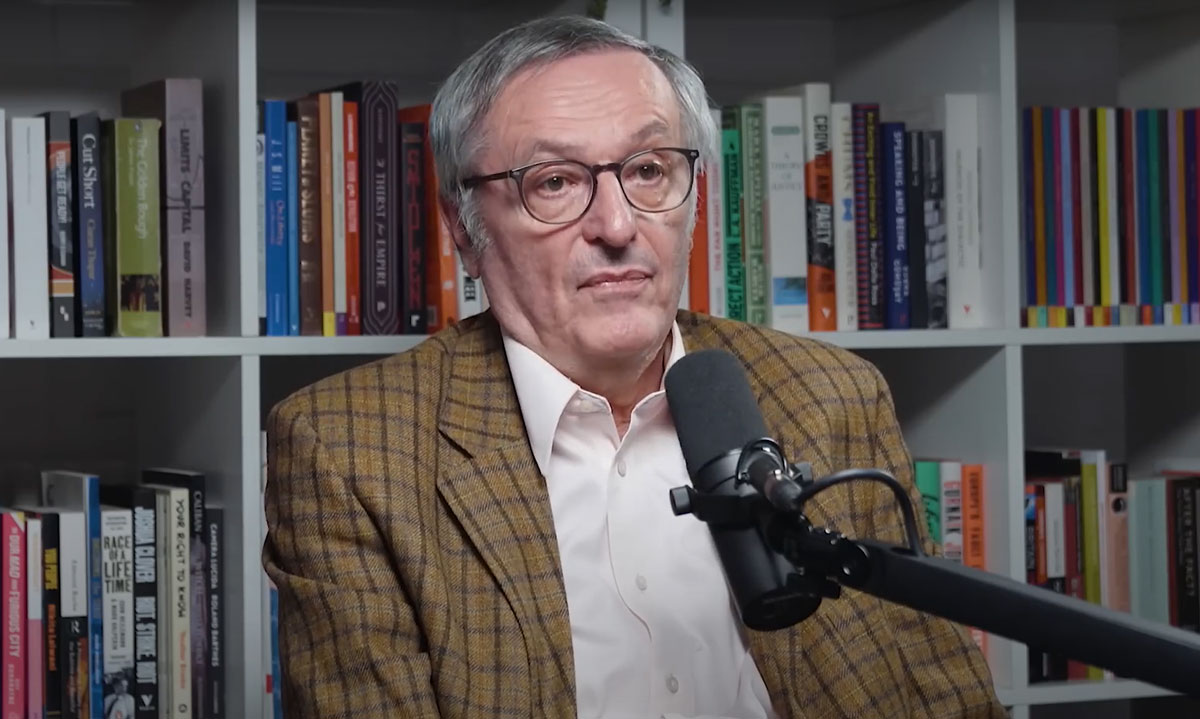by David Morgan
Dangling in mid-air, the bald man works diligently, sifting through clues to a monumental puzzle, piece by piece. Across one wall of a forbidding twenty-first century archive he has pasted the headlines of newspapers and magazines from around the world, dated 1996-97, announcing five thousand million deaths from a ravaging plague. The mutated virus, origin unknown, has left the surface of the planet uninhabitable. Only by “sealed-suit” excursions into the outside air and transportation back in time can information for a cure be obtained, to rescue what remains of humanity.
This could be the last gasp of civilisation as we know it. It could also be the distorted, “mentally divergent” vision of James Cole, a violence-prone lunatic being held for psychiatric evaluation at a Baltimore institution in 1990. Cole (Bruce Willis) believes he is an emissary from the future, charged with discovering this epochal event’s cause, which he suspects may be the mysterious “Army of the 12 Monkeys”.
Directed by Terry Gilliam, Twelve Monkeys is a comical romantic thriller about madness and apocalyptic visions. It was inspired by Chris Marker’s classic 1962 short La Jetée, a rumination on memory, time travel, and a vision of death. It also stars Brad Pitt, as the certifiably crazy son of a noted genetic scientist, and Madeleine Stowe, as the psychiatrist who first treats Cole, and who begins to question her own rational, science-based view of reality.
The script, by David Peoples (Blade Runner, Unforgiven) and his wife Janet, plays with the point of view of Cole, who perceives past, present and future as a jumble of faces, voices and places that overlap, or exist in more than one context. Adding to his tortured psyche is a vivid dream of a young boy at an airport, which portends both freedom and murder. But his disjointed perspective only heightens his yearning for freedom, as he searches for a time in which he can exist not as a prisoner or mental patient, but on his own terms.
Like Cole, Gilliam may feel himself a bit out of his time (or his mind), having been away from feature film-making since 1991, only to find himself working with Hollywood megastars, shooting in the industrial wastelands of Baltimore and Philadelphia, on a budget of $30 million – small by Munchausen standards, but tidy enough.
“The weirdest thing is just starting up again after a long hiatus,” he told me on his way to the set on a brisk late April morning. “Four years of doing other things, such as playing with Hi-8 cameras, which ace fast, you get – well, I’m not sure lazy is the word but you have to get back in the rhythm of shooting, which is very different from imagining films.”
Elliptical though it may be, he claims that this material is straighter than anything he’s done before. But he can’t seem not to go to extremes with his imagery, using wide-angle lenses and brutal closeups to make Cole’s visions and surroundings even more hellish and claustrophobic. Indeed, scenes shot in the decayed Eastern State Penitentiary in Pennsylvania – built by Quakers in the 1820s, turned into a mental hospital by Gilliam’s crew – exude a suffocatingly disturbing air. Which, this being a Terry Gilliam film, is really saying something.
He and production designer Jeffrey Beecroft (Dances with Wolves, The Bodyguard) strenuously sought to avoid designing and shooting in any style that called to mind earlier Gilliam films. They felt the freshness of Twelve Monkeys’ script deserved its own special visual trademark (just as La Jetée‘s haunting static images evoked a unique place, outside of time). Much of their inspiration, at least for those scenes employing Cole’s haunted POV, comes from the sadness of Josef Sudelc’s photography, as well as the fantasies of illustrator Lebbeus Woods, whose radical architectural designs have never been built because they wouldn’t stand up.
Mildewed future
Yet old habits die hard. Walking into the shell of the decommissioned Westport Power Plant, where they are shooting, a stone’s throw from the Patapsco River in Baltimore, you cannot help but think that this is the Ministry of Information in Brazil. The acrid aroma of light-diffusing smoke (standard on Gilliam’s sets) mixes with the mildewy smell of the shuttered plant. At the time of its construction in 1906, this was the largest reinforced concrete power station in the world. The belly of this industrial dinosaur now holds yellowing, tattered Rube Goldberg set décor. It fits in nicely, as if it’s always been here, at one with the grime.
This is the primary set for scenes designated “Eternal Night”, a futuristic interrogation/debriefing centre in which the mentally unstable Cole has his brain picked. Embraced by sweeping tin walls, the cavernous “Engineering Room” is festooned with industrial detritus – electrical meters, manual typewriters and dentist’s drills – along with more routine science- fiction props: video screens and people wearing plastic-covered labcoats (sterile environments, as well as clean consciences, are on most characters’ minds in this stray). Ventilation units made out of old airplane parts resemble iron- lung machines, as they “breathe” clean air into this underground habitat.
“It just seems that I have this German-Expressionistic-Destructivist-Russian-Constructivist view of the future,” Gilliam says with a shrug.
“It’s really hard not to do some of Brazil,” says Beecroft, discussing Cole’s subterranean refuge. “But if the world stopped today, and you can only take things down below now, what could you find down there? These people put all this stuff together, and then had to kind of make up things, jerry-rig machines together, so they’re hydraulic and steam-driven. In terms of lasers and all that stuff, we could have gone that way, but it’s not as fun.”
Actually, the lack of high-tech futuristic gadgetry reinforces the idea that the world is spun from what Cole knows and finds familiar; images, props and décor from one “time” reappear in another context, forcing him (and the audience) to question exactly how this information should be processed.
A huge apparatus resembling a globe outfitted with more than a dozen videoscreens hangs on a gimbal, as if awaiting its cue. This “Video Ball” projects the discombobulated half-faces of the inquiring scientists, and the director himself fusses with a live video-feed camera, producing an excruciatingly unflattering close- up of one of his actresses. Once the camera rolls, the ball swoops and dips in and out of shot, menacing Willis (strapped into a chair 12 feet above the stage) like a coiled viper.
Scattered throughout the Westport plant are other futuristic sets, in whole or parts. An air lock – a long, hollow tube about six feet in diameter that looks like it’s bleeding rust – rests near the plant’s entrance, not far from the caterer’s stash of pretzels and trail-mix. And a contraption dubbed the Chrysalis (a gurney wrapped in plastic that gets hoisted up into the air) serves as a time machine, squeezing Willis – like toothpaste – into the past.
Yet despite the sci-fi trappings of time-travel and mutating viruses, the story is primarily a search for redemption amidst a crazy, unfeeling world. This rugged individualist standing tall against a crushing society that more often than not passes painful judgments parallels Gilliam himself: a visionary film-maker standing tall against a crushing industry that more often than not produces lousy movies (his love/hate relationship with the American film industry is well-documented).
An acclaimed cult favourite for his technical savviness, arresting visuals and mordantly satirical humour, the ex-patriate American Gilliam (Time Bandits, Brazil, The Adventures of Baron Munchausen) was for years seen by Hollywood studios as of little consequence, as he made them no money. After his lighter mainstream comedy The Fisher King opened to very good reviews and box office four years ago, Gilliam was ready for Hollywood to come courting.
It didn’t quite work out. While his script-work on an adaptation of Don Quixote was giving him fits, The Defective Detective (a comedy/fantasy co-written with Richard LaGravenese, screenwriter of The Fisher King) was put into turnaround, and A Tale of Two Cities (announced with Mel Gibson as the star) fell apart. Gilliam also learned (from a press release!) that he was to direct A Connecticut Yankee in King Arthur’s Court, for a producer who then never got it before the cameras. “It reached a point where I went crazy,” he said.
We’re all doomed
The timing of Twelve Monkeys’ arrival on Gilliam’s plate was therefore propitious, particularly as the themes in the script resonated strongly within him. “The thing is so varied: the places we go, the times we go in. It’s a chance to do a little bit in the future, a little in the past, and the tone is very odd. It plays with the same old things – time, reality, madness – so I was intrigued. And it was romantic.
“I think what I liked most were the rantings of Jeffrey Goines, who Brad Pitt plays, because David and Janet were saying the kinds of things that Richard LaGravenese and I were trying to say in our script, only they were clever to put all these things that we all feel but are terrified to say into the mouth of a madman. Suddenly they became funny, rather than the way we were working on it.”
Madness has always been an integral trait of Gilliam’s characters, whether their mental illness, or the sheer hubris of Man trying to battle the superior forces of Nature. It may serve the dramatic functions of escape, of weapons against authority, or of keys to spiritual enlightenment, but it is usually played out as one man’s fantasies against the world, the audience siding with the individual.
In Twelve Monkeys, however, the film-makers force the audience into a trickier situation: since Cole’s perception is what we the viewers are allowed to see, we have to decide whether it’s the truth, or a crazily distorted vision of one man’s gravest fears. It would be easy to write off his strained logic and jumbled note-taking as a loony’s. But despite his fragile state of mind, we see his intrinsic humanity, and so we want to see him healed and well. However, if we are rooting for Cole to be sane, that means accepting that he is telling the truth – ergo, we are all doomed to perish, by the millions. This is not standard material for a comfortable, audience-pleasing tale – which is why Gilliam is doing it.
Twelve Monkeys is also rare as a Gilliam piece in that he did not develop and write it himself. “It’s one thing to get lost in your own madness,” he says, “but to become lost in somebody else’s madness is weirder.” And unlike The Fisher King, where LaGravenese was on the set throughout the shoot to confer with the director, Gilliam does not have the writers with him, and so is prone to mistrust his interpretation.
“I’m not certain that I’m totally comfortable with taking somebody else’s idea or script and trying to work with it. And the words are really good. I mean, this is in some ways more serious than anything I’ve done. That was intriguing, but also very unnerving, because I was never certain whether I’m being boring because everything’s straight; yet I don’t want to juice it up with weirdness that gives it away.
“I start worrying that my images are distracting from the story, drawing attention to me being clever as opposed to the characters playing out the scene. I know there’s one scene I just made much more bold and beautiful. It could have been very simple, and it may have been bold just keeping it simple. So my need to elaborate is rearing its ugly head.”
Curiously, Twelve Monkeys is being paid for and released throughout most of the world by Universal, whose previous management once so stirred Gilliam’s ire by its handling of Brazil. Even more curious, producer Charles Roven is married to Dawn Steel, former head of Columbia Pictures, whom Gilliam had in the past vilified as the woman who drove the stake into Munchausen’s heart. “I think that the irony of it was too much for Terry to resist,” says Roven.
As the crew treks to the parking lot for some pick-up shots, meant to match exteriors filmed several weeks earlier about 100 miles away, Gilliam muses on the size of the operation he leads: “Smaller would be fun. My problem always is my ideas are just big and expensive. By Hollywood terms we’re not a big movie; we’re under $30 million, with three big stars in it – that’s pretty amazing. So we’re doing a cheap movie by those standards. [Still], it’s hard to control all of it; everybody is doing things and you can’t be everywhere at once. Look at the circus we’re carrying around with us. I know we’re supporting the Teamsters and their families, and I think that’s a wonderful thing.”
Not to mention the local ice manufacturers. On this sunny spring afternoon, hundreds of pounds of cracked ice have to be unloaded and strewn across the asphalt for shots of Cole climbing out of an underground passage onto the virgin snows of a desolate, future Philadelphia. Watching the wintry landscape being spread into place reminds one of an old Python sketch, in which a film crew transforms the beaches of Paignton into the Antarctic, through the use of paint and 28,000 cubic feet of white foam rubber (“which actually on screen looks more like snow than snow”).
Unlike that sketch’s gushing producer, Gilliam is less impressed by the effort here. “The script originally was to be set in autumn,” he said. “It got pushed later and later, to Christmas, and then it was, well, do we go for snow or no snow? The first week we were going back and forth, depending upon how the weather went, and the weekend we started it snowed. An omen! So we went with snow. And it’s never snowed since! So we’ve been going on like this.”
In latex, and ill-at-ease
Fingers poke out from beneath the carefully swept faux snow, wriggle through tiny holes in the surface, and push aside a manhole cover – whereupon out climbs Willis, tossing out a specimen case and torch. He is adorned in his sterile suit, a plastic-shrouded costume not unlike the deep-sea divers’ outfits in a Jules Verne epic, which he wears over a latex bodystocking. “A human condom,” Gilliam quips.
During a break, Willis helps a young visitor scrape off her lottery ticket, before retreating to his solitary stage to capture specimens. Coming upon a rusted car, he retrieves a Madagascan hissing cockroach (according to the film’s animal wrangler), then reels back from the loud bellow of a grizzly bear, filmed weeks earlier.
Though a physically demanding role, as always, this character is unusual for Willis. More often a heroic figure seeking to assert control while chaos reigns around him, he here plays a mentally unstable, ill-at-ease cipher who feels completely powerless, at the mercy of others. Cole accepts his helplessness, rejecting one doctor’s suggestion in 1990 that his destiny is to prevent the 1996 plague: saying “Save you? How can I save you? It already happened!” But from his weakness, and his questioning of his own sanity, he learns to shape his destiny.
Gilliam says, “One of the reasons [for doing Twelve Monkeys] was taking Bruce and putting him into situations and asking of him things I don’t think he’s ever done before or that people haven’t seen him do – maybe done privately, but he’s not done it publicly. And that’s pretty interesting, and with Brad Pitt it’s the same thing. Brad is pretty laconic in some ways. Suddenly he’s a blabbermouth, jabbering away at high speed. I love doing that, playing with the public’s perception of that star; otherwise, it wouldn’t be fun.
“It’s a very different experience working with stars. I’m not used to the American system, that allows stars incredible latitude. They’re just not used to working the way we used to work in England, where we’re just more matter-of-factly getting on with it. Here, people are frightened of the success of successful people. It’s much more hierarchical, there’s more fear in the air. It’s odd.”
Twelve Monkeys may prove to be Gilliam’s most intimate film; despite the disturbing imagery and doomsday subtext, Cole’s struggle for mental clarity and his bonding with Stowe’s psychiatrist are powerful elements in the script. But the focus upon characterisations, as opposed to fantastic opticals, hasn’t necessarily made Gilliam’s job easier.
“There actually hasn’t been any technical challenge on this, it’s all been me avoiding technical challenges. I tried to do this thing without getting caught in all the tricks I’ve done in the past – blue screen, all those things. In Brazil when we did the driving shots we had cloth backgrounds we were pulling around.
“This time, I thought I wanted to do things just like everybody else does, the way they do it in a real movie. But when you’re towing a vehicle or putting it on the back of a low loader, you can’t be in there with the actors. And they get distracted; it’s hard to get good performances. Now when you’re doing it [in the streets] the senses are being battled; the wind’s blowing, everything’s banging, crashing, it’s very exciting! Then you look at it on film, and the performances are not what they should be, so what the fuck are we doing? It’s a great waste of time.
“So we’ve reverted to using all these old tricks, going with blue screen and a car on a stage, and the performances are really good now. I had thought it was the complicated way of doing things; in fact, it’s the more intelligent way of doing things.”
Published in Sight and Sound, January 1996, pp. 18-21




